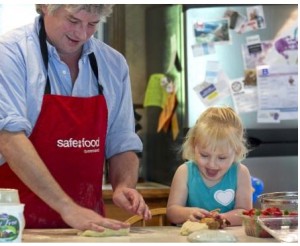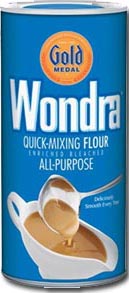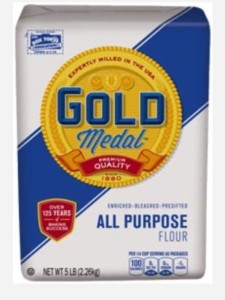For all the food companies that brag about traceability, why does it take so long to figure out that your suppliers are in a recall and maybe you should be too?
 The lingering, lasting recalls involving products that contain E. coli O121- tainted wheat from General Mills, Listeria-tainted frozen produce from CRF Frozen Foods in Pasco, Wash, and Listeria-tainted sunflower kernels from SunOpta, pile up daily.
The lingering, lasting recalls involving products that contain E. coli O121- tainted wheat from General Mills, Listeria-tainted frozen produce from CRF Frozen Foods in Pasco, Wash, and Listeria-tainted sunflower kernels from SunOpta, pile up daily.
Yesterday, the girlfriend of my much younger youth, Betty Crocker, recalled cake mix in Canada because it possibly contained E. coli flour from General Mills.
But how could I not lick her spoon, or sample her beater, as a child or an adult?
Randy Shore of the Vancouver Sun asked me those questions the other night during a conversation about risk, cookie dough and preaching.
I said I don’t preach, I provide information, people can do what they like, but it really sucks if your kid gets a Shiga-toxin producing E. coli like O121 because it’s a serious illness, often with lifelong consequences.
And it’s a scam that for all the prowess and profits of these companies, from Betty, to Golden Dipt brand Jalapeño Breader, to Planters Sunflower Kernels, they can’t figure out who is supplying their shit ingredients.
Markets/local/sustainable/whatever adjective are no better.
It’s food fraud.
Rick Holley, a professor emeritus of food safety at the University of Manitoba in Winnipeg (that’s in Canada) told CBC News that eating foods that aren’t well cooked is sorta like the risks people take when they jaywalk and don’t cross the street at a traffic light or stop sign.
“We know only too well that there are folks who like to eat food that’s not well cooked or isn’t cooked and against the best advice, because the food we eat is not sterile — there are risks associated with it. Having said that, I enjoy my salad in the summer time. Uncooked.
“Where we need also to do some work is on maintaining and improving the levels of sanitation in all parts of the food system, food processing plants. We know from investigations that have been done both in Canada and the United States that when there are lapses in sanitation, problems occur in food processing plants. We can see it now happening in mills.”
 According to Shore at the Vancouver Sun, the U.S. Food and Drug Administration has warned people not to eat raw cookie dough, effectively killing the fun of making cookies.
According to Shore at the Vancouver Sun, the U.S. Food and Drug Administration has warned people not to eat raw cookie dough, effectively killing the fun of making cookies.
1.) How serious is the cookie dough threat?
In 2009, at least 71 people in 31 states were sickened by Nestle Tollhouse cookie dough contaminated with E. coli O157: H7. While nobody died, 11 people suffered serious complications. Nestle now uses heat-treated flour.
2.) What about homemade cookie dough?
The flour you use at home to make cookies has likely not been treated to kill salmonella and E.coli, so it should not be eaten raw. Irradiation is used to control insects in flour, not bacteria, so don’t depend on it for food safety.
3.) What about cookie dough ice cream?
Cookie dough ice cream is a guilty pleasure, but you can eat it without risk. Ben & Jerry’s cookie dough is made with pasteurized eggs and heat-treated flour. Most manufacturers, including Dreyer’s and Haagen-Dazs, use similar methods.
4.) What will happen to me?
According to the Canadian Food Inspection Agency, rainbow bits contaminated with E. coli O121 may not look or smell spoiled but can still make you sick. Symptoms can include nausea, vomiting, mild to severe abdominal cramps and watery to bloody diarrhea. In severe cases of illness, people may die.
5.) Should I panic?
While the CFIA is so far silent on the issue, the FDA warns that you should not eat or allow your children to play with raw flour products, including homemade PlayDoh. If you make cake, cookies or pancakes, don’t lick the beaters.
Julia Calderone of Consumer Reports lists her own five ways you could get an E. coli infection from flour.
They’re not that surprising to microbiology-types.
Be the bug. Follow the bug (especially animal poop).
Since December 2015, 42 people across 21 states have developed an E. coli infection after eating uncooked flour. The outbreak is caused by a potentially dangerous strain of E. coli called O121.
Like E. coli O157, which has been responsible for food poisoning outbreaks from undercooked ground beef, O121 is a toxin-producing bacteria that may cause abdominal cramps, bloody diarrhea, and possibly life-threatening kidney damage. Fortunately, so far no one who has become ill from flour or flour-based products has developed kidney damage or died, but 11 people have been hospitalized.
Products produced at a General Mills plant in Kansas City, Missouri, in November 2015 are the culprits behind these cases of E. coli infection. The company voluntarily recalled 10 million pounds of possibly contaminated flour, including their Gold Medal, Signature Kitchens, and Gold Medal Wondra flour brands. Several cake and pancake mixes that may have used General Mills flour have also been recalled.
The U.S. Food and Drug Administration and the Centers for Disease Control and Prevention are currently investigating these cases of E. coli infection, and are advising consumers not to eat flour and flour-containing foods that have not been cooked or baked. Consuming raw flour is a potential hazard, says the FDA, since it isn’t meant to be a ready-to-eat product.
Some of the ways you could ingest uncooked flour may not be so obvious. Here are five sources of potentially tainted flour that you should watch out for if you want to prevent a possible associated E. coli infection.
- Raw doughs and batters.Of course, cookie doughs, pizza doughs, and cake and pancake batters are risky, so you should be careful not to accidentally or intentionally eat them before they’re cooked.
But raw dough can also make you sick even if you don’t intend to eat it. For example, kneading bread dough often leaves you with floury hands. Some restaurants give children balls of uncooked dough to play with, and they could stick either the tainted ball or their contaminated fingers into their mouth. Even storing uncooked dough next to other foods could cause a problem, so be sure to handle and stash it carefully.
- Arts and crafts materials.Websites devoted to pantry-based projects offer recipes for modeling clays, play doughs, spray glue, paper mache, and ornaments with flour as the main ingredient. For now, avoid making these mixtures with kids, and be sure to wash your hands and work surfaces thoroughly afterward if you decide to work with them.
- No-cook dishes.Some flour-containing recipes for truffles, icing, and even cookies don’t involve heating or baking. So if the recipe doesn’t call for the dish to be thoroughly cooked, skip it.
- Contaminated cooking and eating surfaces.Flour is light and powdery, and can easily fly everywhere in your kitchen if you aren’t careful. Even miniscule amounts of tainted flour can make you sick, so be sure that foods that will be eaten raw don’t come into contact with flour-dusted counters, cutting boards, plates, and the like. Wash these—as well as your hands—in hot soapy water after using them. Be careful if you’re dredging meat or chickenin flour before cooking, so the flour doesn’t go all over the place.
- Containers you use to store flour.When you purchase a new bag of flour, you might dump the new flourinto a flour bin or canister that has some old, recalled flour already in it, unwittingly contaminating your new stash. If you’re not sure if the flour you currently have has been recalled, throw it out. Make sure that you thoroughly clean your storage container before using it again.
 To date, there have been no reports of illness associated with consumption of this product.
To date, there have been no reports of illness associated with consumption of this product.














